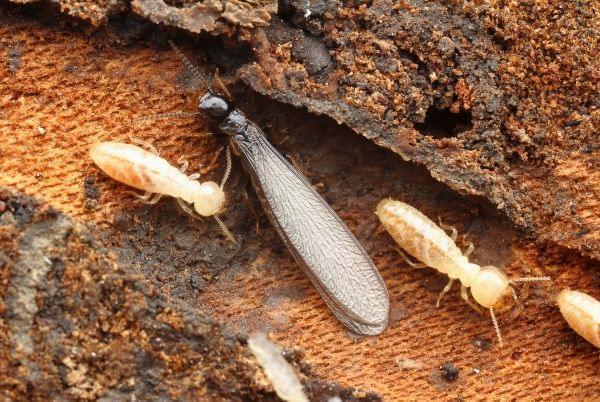Termites are much more than just pests

Subterranean termites of the species readers are most likely to know, Reticulitermes flavipes. They're one of the few species people really do have cause to dislike! Alex Wild Photography (with permission)
On Saturday, the 36th Annual Insect Fear Film Festival will take place in Foellinger Auditorium, on the UI campus. As part of the celebration, this week’s commentary is written and voiced by two graduate students from the Department of Entomology, Scott Clem, Rachel Skinner, and Jonathan Tetlie. The theme for this year’s festival is “Termites!”
Scott: Despite the sadistic portrayal of these insects in the festival’s feature film, termites are truly fascinating. They are classified as exhibiting the highest level of sociality, termed eusociality, in which individuals cooperate as a group and exhibit a caste system consisting of workers, soldiers, and reproductives. The reproductives, or kings and queens, are important for establishing new colonies. They emerge in massive winged swarms (termed nuptial flights) where virgin queens mate with short-lived kings, and disperse to form new colonies.
Termite colonies can become massive. In Brazil, a super-colony estimated to be nearly 4,000 years old and consisting of nearly 200 million mounds covers an area the size of Great Britain and is visible from space! Some of these mounds are over 10 feet tall.
Termites are also fascinating at the microscopic level. They host an entire community of specialized, symbiotic microorganisms that break down unpalatable cellulose into simpler digestible molecules.
Rachel: Most people solely associate termites as being wood-eating pests that destroy homes and wreak havoc on wooden structures. However, with over 3,100 species described throughout the world, only a select few of these insects are granted this infamous reputation, while all provide vital ecosystem services.
Termites are essential decomposers of wood and other cellulose materials, and they are a major food source for a variety of organisms--including humans! In a number of cultures, termites are collected in during nuptial flights, clipped of their wings, and either roasted or fried. Because their nutrient density and ability to convert inedible waste into consumable products, termites have been proposed as a potential sustainable source of food in space.
Termites have been associated with numerous bio-inspired design projects. Modern buildings have begun to incorporate passive cooling inspired by termite nest design. The Eastgate Centre in Zimbabwe, for example, has incorporated this system and is incredibly energy efficient, using only 10% of what is required by a comparable, conventional building.
Jonathan: Why did termites incorporate temperature control elements in the first place? Certain species of termites grow fungal farms in their nests as a source of nutritious and digestible food. However, this creates a problem because the fungi require a specific temperature in order to survive. Termites solve this by creating a vast array of heating and cooling vents which can be manipulated to regulate airflow and temperature.
Not convinced that termites are more than just pests that destroy the foundation of your home? Stop by the Insect Fear Film Festival on February 23 to learn more about these amazing creatures!
Doors to Foellinger Auditorium open at 6:00 p.m. for exhibits and activities. Specific to the theme of this year’s film festival, there will be termite exhibitions including exotic termite displays, termite puppets, and live termites you can manipulate using pheromones. An introduction by Entomology department chair, May Berenbaum, will be given at 7:00, followed by animated shorts and our feature film. Admission is FREE! For more information, For more information, check out the IFFF webpage or find it on Facebook

